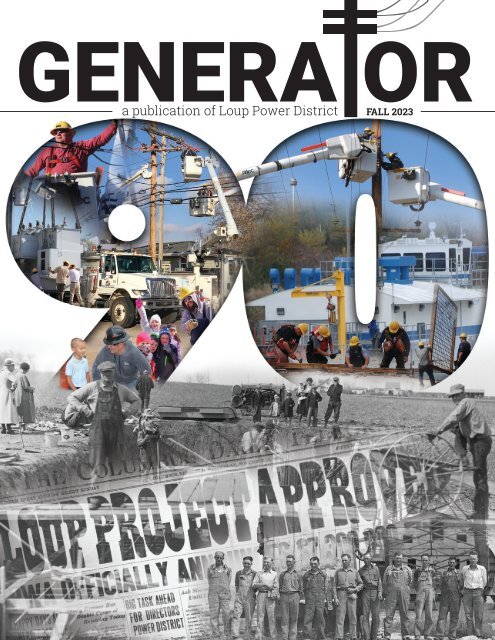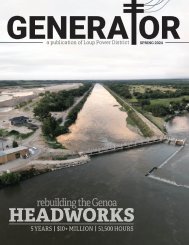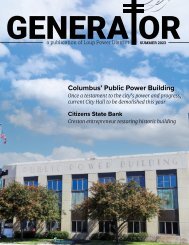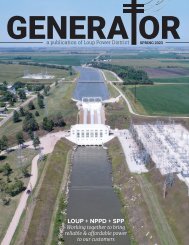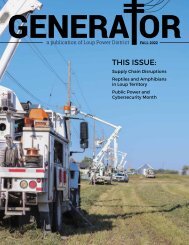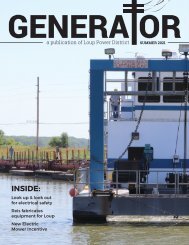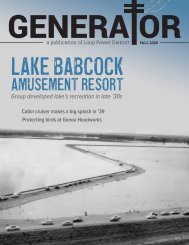Generator—Fall 2023
Loup is 90 years old! Learn more about our interesting history in this edition of the Loup Generator. Other topics include Public Power Month, cybersecurity tips, and a retiree feature on Jim Jakub.
Loup is 90 years old! Learn more about our interesting history in this edition of the Loup Generator. Other topics include Public Power Month, cybersecurity tips, and a retiree feature on Jim Jakub.
You also want an ePaper? Increase the reach of your titles
YUMPU automatically turns print PDFs into web optimized ePapers that Google loves.
GENERA OR<br />
a publication of Loup Power District FALL <strong>2023</strong>
BOARD OF DIRECTORS<br />
Steve Heesacker<br />
Chairman<br />
Bob Cerv<br />
First Vice Chairman<br />
Jim Donoghue<br />
Second Vice Chairman<br />
Mike Fleming<br />
Secretary<br />
Dick Tooley<br />
Treasurer<br />
Rich Aerni<br />
Alan Drozd<br />
Larry Zach<br />
EXECUTIVE STAFF<br />
Neal Suess<br />
President/CEO<br />
Walt Williams<br />
Vice President,<br />
Accounting & Finance/CFO<br />
Todd Duren<br />
Vice President,<br />
Corporate Services<br />
Korey Hobza<br />
Vice President, Engineering<br />
Dan Hellbusch<br />
Vice President, Operations<br />
The Loup Generator is<br />
published quarterly<br />
as a service for Loup<br />
employees, families,<br />
friends, and associates.<br />
For feedback, story ideas,<br />
and submissions, contact:<br />
Stacy Wemhoff<br />
Communications Coordinator<br />
402-562-5711<br />
swemhoff@loup.com<br />
2 | GENERATOR<br />
Protect yourself from cyber<br />
criminals with these tips<br />
In today’s digital world, cyberattacks<br />
are unfortunately nothing new. Cyber<br />
criminals can attack on a multitude of<br />
levels, from large-scale attacks targeting<br />
corporations to smaller phishing attacks<br />
aimed at gaining an individual’s personal<br />
information.<br />
October is Cybersecurity Awareness<br />
Month, but good cyber hygiene should be<br />
practiced year-round. This year’s theme is<br />
“See Yourself in Cyber” – because we all<br />
have a part to play in cybersecurity. When<br />
we hear about massive data breaches, it<br />
can feel overwhelming and lead us to think<br />
we’re powerless as individuals to stop<br />
cyber criminals.<br />
However, there are several practical steps<br />
we can take to safeguard our devices and<br />
data. Here are four easy ways to boost your<br />
cyber hygiene:<br />
1. ENABLE MULTI-FACTOR<br />
AUTHENTICATION.<br />
Also known as two-step verification, multifactor<br />
authentication adds a second step<br />
when logging into an account (to prove<br />
you’re really you), which greatly increases<br />
the security of the account. This second<br />
step could include an extra PIN, answering<br />
See Yourself<br />
in Cyber.<br />
October is Cybersecurity<br />
Awareness Month<br />
Improve your cyber<br />
hygiene by doing<br />
these four things:<br />
1. Enable multi-factor<br />
authentication<br />
2. Use strong<br />
passwords and a<br />
password manager<br />
3. Update software<br />
regularly<br />
4. Recognize and<br />
report phishing<br />
attacks<br />
an extra security question, receiving an email code, or a secure token. Regardless of the type of authentication,<br />
this additional step makes it twice as hard for cyber criminals to access your account. Not every<br />
account offers multi-factor authentication, but it’s becoming increasingly popular and should be utilized<br />
when available.<br />
2. USE STRONG PASSWORDS AND A PASSWORD MANAGER.<br />
Remember, passwords are the “keys” to your personal home online. Your passwords should always be<br />
long, unique and complex. Create passwords using at least 12 characters, never reuse passwords for<br />
multiple accounts, and use a combination of upper- and lower-case letters, numbers and special characters.<br />
If you have a lot of accounts, consider using a password manager app to store them easily and<br />
securely in one place.<br />
3. UPDATE SOFTWARE.<br />
It may seem obvious, but regularly updating software is one of the easiest ways to keep your personal<br />
information secure. Most companies provide automatic updates and will send reminders so you can<br />
easily install the update. If you’re not receiving automatic software updates, set a reminder to do so<br />
quarterly. Be aware that some cyber criminals will send fake updates; these typically appear as a pop-up<br />
window when visiting a website. Use good judgement and always think before you click.<br />
4.RECOGNIZE AND REPORT PHISHING ATTACKS.<br />
Don’t take the bait when cyber criminals go phishing. The signs of a phishing attack can be subtle, so take<br />
the extra time to thoroughly inspect emails. Most phishing emails include offers that are too good to be<br />
true, an urgent or alarming tone, misspellings and poorly-crafted language, ambiguous greetings, strange<br />
requests, or an email address that doesn’t match the company it’s coming from. Most platforms like<br />
Outlook, Gmail, and Mac Mail allow users to report phishing emails. If you suspect a phishing attempt,<br />
take an extra minute to report it.<br />
Cyber criminals are here to stay, but when we all take a risk-based approach to our cyber behavior, we’re<br />
creating a safer internet for all. Visit www.staysafeonline.org for additional cybersecurity tips.
president’s message<br />
Economic development one<br />
of Loup’s main objectives<br />
Loup Power District has three main<br />
objectives that have been in place since the<br />
District initially started business. These<br />
three objectives are:<br />
1. To provide reliable electric service to its<br />
customers at rates that are fair, reasonable,<br />
and non-discriminatory and to bring to its<br />
customers the rewards of an efficient and<br />
prudent operation.<br />
2. To improve and promote the economic<br />
development in our area.<br />
3. To make maximum use of the water of the<br />
Loup River to generate power.<br />
I want to focus on the second objective that<br />
deals with economic development.<br />
The District works to promote the benefits<br />
of our service territory to existing and new<br />
businesses looking to grow in this area. We<br />
work with communities we serve as well as<br />
the the economic development agencies in<br />
those communities.<br />
Each new business opportunity brings new<br />
challenges, including workforce issues,<br />
housing and in some instances, the ability<br />
to serve the load with existing or newly<br />
proposed infrastructure additions.<br />
We want to be sure existing businesses<br />
are not affected by new opportunities. The<br />
workforce challenge seems to be one of<br />
the greatest issues this area has faced in a<br />
number of years.<br />
With low statewide unemployment levels,<br />
finding new workforce to locate to the area,<br />
and subsequently, finding housing for that<br />
workforce has forced the District and our<br />
economic development partners to really<br />
up our game in this area.<br />
District personnel have worked with our<br />
communities to promote job fairs at local<br />
universities and community colleges and<br />
have worked on various proposals to bring<br />
more workers to this area. This is always a<br />
challenge, as bringing in people who have<br />
never lived in this area can sometimes be<br />
difficult on families looking to relocate.<br />
This is why the District also works with<br />
communities on housing issues, quality of<br />
life issues, and the overall betterment of the<br />
communities. We want to provide a familyoriented<br />
and safe place for families to<br />
relocate to and settle down. This is the true<br />
testament to economic development.<br />
Obviously, the District’s main goal is to<br />
provide electricity to our customers, but<br />
these other facets play an important part of<br />
our daily work life.<br />
Being able to provide a good quality of life<br />
in our area benefits our employees as well<br />
and makes it one of the reasons that I love<br />
Loup Power District and the four-county<br />
area that we serve.<br />
NEAL SUESS<br />
President/CEO<br />
FALL <strong>2023</strong> | 3
RETIREE PROFILE:<br />
Jim Jakub serves fellow veterans<br />
Jim Jakub is one of nearly 2 million men drafted by the<br />
United States military to serve in the Vietnam War.<br />
He attended basic training at Fort Polk in Louisiana<br />
shortly after his graduation from Schuyler Central High<br />
School in 1969. After that, he headed to Fort Bliss in<br />
Texas for advanced training on M42 Dusters and Quad 50<br />
machine guns. Then he went to Air Defense NCO Candidate<br />
School and received his E-5 Sergeant stripes.<br />
And then he volunteered to go to Vietnam.<br />
“I wanted to help defend my country even though it was<br />
a very unpopular war,” he said.<br />
Jakub lead his squad for a year and then served seven<br />
years in the Army Reserve.<br />
More than 50 years later, Jakub has no regrets about his<br />
nine-year military career.<br />
“I’m very proud of my service,” he said. “I would do it<br />
again.”<br />
I’m very proud of my service.<br />
I would do it again.”<br />
Back in Nebraska, Jakub settled in Columbus with<br />
his wife, Elaine, and began his career and his family. He<br />
worked for a few different employers over the years and<br />
then someone suggested he apply at Loup Power District.<br />
He got the job and began his career as a Plant Operator<br />
at the Columbus Powerhouse.<br />
“It was a new challenge,” Jakub said. “And I like<br />
challenges.”<br />
Jakub ended up working at Loup for 20 years, retiring<br />
in 2014. It was during that time, that he learned about<br />
Disabled American Veterans (DAV) group while attending a<br />
Veterans Day program. Jakub — a member of the VFW and<br />
American Legion — wanted to know more about the group.<br />
The more he learned, the more he realized he was ready<br />
for a new challenge: serving veterans with the DAV.<br />
***<br />
The DAV’s main objective is working with veterans and<br />
their spouses and families to get the benefits they have<br />
earned through their service.<br />
Jakub said the paperwork is complicated. Veterans need<br />
help filling it out, providing the proper documentation,<br />
and submitting their claims.<br />
The DAV also offers transportation services to veterans<br />
in certain areas and has a disaster relief program.<br />
“DAV is there to assist veterans in many ways,” he said.<br />
Jakub added that some veterans, such as those who<br />
served in the National Guard and Reserve, feel they don’t<br />
deserve benefits, especially if they haven’t gone oversees<br />
or been in combat situations. Jakub assures they them are<br />
indeed veterans and need to have a DAV service officer help<br />
them with their claims.<br />
“I tell them, ‘If you raised your right hand and swore<br />
allegiance to this country, you signed a blank check and<br />
now we need to take care of you,’” he said.<br />
Jakub signed that blank check. But he’s not the only one<br />
in his family to do so.<br />
He had two brothers who also served in the Vietnam<br />
War. One was in Vietnam at the same time serving with the<br />
Army. The other was in Thailand with the Air Force. Jakub<br />
acknowledges that having three children serving overseas<br />
at the same time had to be difficult for his mother.<br />
“I think that’s why my mom colored her hair,” he joked.<br />
Jakub’s father, Edward, served in World War II on the<br />
island of Saipan. His son, Jamie, is an Air Force Officer and<br />
the Adjutant for the Department of Nebraska DAV.<br />
4 | GENERATOR
DAV (Disabled American Veterans) is dedicated to a single purpose:<br />
empowering veterans to lead high-quality lives with respect and<br />
dignity. We accomplish this by ensuring that veterans and their<br />
families can access the full range of benefits available to them;<br />
fighting for the interests of America’s injured heroes on Capitol Hill;<br />
and educating the public about the great sacrifices and needs of<br />
veterans transitioning back to civilian life.<br />
This mission is carried forward by:<br />
• Providing free, professional assistance to veterans and their<br />
families in obtaining benefits and services earned through military<br />
service and provided by the Department of Veterans Affairs (VA)<br />
and other agencies of government.<br />
• Providing outreach concerning its program services to the<br />
American people generally, and to disabled veterans and their<br />
families specifically.<br />
• Representing the interests of disabled veterans, their families,<br />
their widowed spouses and their orphans before Congress, the<br />
White House and the Judicial Branch, as well as state and local<br />
government.<br />
• Extending DAV’s mission of hope into the communities where<br />
these veterans and their families live through a network of<br />
state-level Departments and local Chapters.<br />
• Providing a structure through which disabled veterans can<br />
express their compassion for their fellow veterans through a<br />
variety of volunteer programs.<br />
• Connecting veterans with meaningful employment and preparing<br />
entrepreneurs to become job creators. DAV empowers veterans<br />
to pursue their maximum potential through DAV career fairs and<br />
intensive training. DAV job fairs have led to more than 168,000 job<br />
offers for veterans and spouses.<br />
DAV IS FUNDED THROUGH DONATIONS. WANT TO HELP?<br />
DAV Chamber #20, 1978 3rd Ave., Columbus, NE 68601<br />
Jim Jakub (left) and his brother Jerome Jakub both served<br />
in the Vietnam War at the same time. They were able to<br />
meet up only once. They are pictured here at the Chu Lai<br />
military base in October 1970.<br />
Jakub is pictured with the Quad 50 anti-aircraft machine<br />
gun that he named Mammy Yokum.<br />
And so, serving veterans is near and dear to Jakub who<br />
served as the Commander of the DAV Chapter #20 for six<br />
years. He also served as Commander of the Department of<br />
Nebraska DAV for three years.<br />
While he still works with the group and advocates for<br />
veterans, health concerns forced him to take a “few steps<br />
back.”<br />
In September 2020, Jakub and his son, Jamie, were at the<br />
airport in Omaha preparing for a trip to pick up two new<br />
DAV vehicles for Nebraska. He was feeling a little run down.<br />
And then he collapsed.<br />
He stayed in the hospital for a few days, got some<br />
medication, and headed home. But he started coughing and<br />
ended up back in the hospital in Lincoln. This time, his stay<br />
was two months.<br />
“I wasn’t supposed to come home,” he said.<br />
Jakub knows how lucky he is to be alive and able to enjoy<br />
his retirement. He and his wife have taken a few bus tours<br />
to spots around the country. They went to Ireland and Italy.<br />
But the best part of retirement is spending more time<br />
with his family.<br />
Two of his sons work in the power industry. Jeff works<br />
at Cooper Nuclear Station. Jonathan is the Manager of<br />
Enterprise Solutions in the Technology Services division at<br />
Lincoln Electric System.<br />
But these days, his three children are overshadowed a bit<br />
by 11 grandchildren and five great-grandchildren. He really<br />
enjoys how easy it is to make it to more of their school<br />
events— something that was a lot more difficult when he<br />
was in the workforce.<br />
While Jakub loves challenges, he’s sure glad that one’s<br />
not on his list anymore.<br />
“I can see my grandkids play sports, go to dances, and<br />
spend more time with them,” he said.<br />
FALL <strong>2023</strong> | 5
6 | GENERATOR
YEARS<br />
1933 – <strong>2023</strong><br />
In the midst of the Great Depression,<br />
word came to Columbus that the<br />
Public Works Administration<br />
awarded $7.3 million to Loup Power<br />
for construction of a power canal.<br />
”Happy days are here,” announced the<br />
Columbus Daily Telegram on Nov. 15, 1933.<br />
It was indeed a happy day for a group of<br />
Columbus businessmen who had worked for<br />
months on the plan. They wanted to reverse<br />
the effects of the Depression and provide a<br />
power source at the same time.<br />
In April of that year, the Nebraska<br />
Legislature passed the Enabling Act, which<br />
established public power and irrigation<br />
districts as political subdivisions of the state.<br />
The Loup River Public Power District was<br />
the first to form in the state of Nebraska. Its<br />
founders went on to apply for the PWA funds<br />
that would be used to build the Loup Power<br />
canal and two powerhouses.<br />
But Loup’s story isn’t just about Loup. It is a<br />
story about public power throughout the state<br />
and nation. Loup helped create Cornhusker<br />
Public Power District and companies that<br />
are now known as Nebraska Public Power<br />
District. It also helped Omaha Public Power<br />
District get up and running.<br />
Harold Kramer, Loup’s first general<br />
manager, was given leave to work full-time in<br />
Washington, D.C., to help start the American<br />
Public Power Association.<br />
Max Kiburz, who later served as general<br />
manager, headed a legislative study group<br />
that eventually became the Nebraska<br />
Power Association and he served as its first<br />
president.<br />
The District also powered economic<br />
development efforts throughout its history.<br />
Columbus claims to have the first industrial<br />
site in the United States and several Fortune<br />
500 companies are now located on land that<br />
once belonged to Loup Power District.<br />
Today, Loup and its employees provide<br />
retail service to customers in Platte, Colfax,<br />
Boone, and Nance Counties, and part of<br />
Madison County.<br />
It also continues to generate electricity<br />
with a canal and powerhouses that have<br />
been meticulously maintained for nearly a<br />
century.<br />
7
1933<br />
In 1933, the Nebraska Legislature passed a<br />
law allowing the formation of public power<br />
districts. Loup River Public Power District<br />
organized in June that year and became<br />
the first public power district in the state.<br />
LOAN & GRANT<br />
The Public Works Administration (PWA)<br />
approved a $7.3 million loan and grant for<br />
the Loup Project on November 15, 1933.<br />
This was a tremendous boost to Columbus<br />
and Genoa. The announcement spurred<br />
spontaneous celebrations. Businesses closed<br />
and residents held torchlight parades.<br />
Before the project could begin, the<br />
District needed to acquire property. Some<br />
landowners were eager to sell. One farmer<br />
sold 26 acres of his 192-acre farm and cut his<br />
$14,000 mortgage in half.<br />
Only 10 percent of land was obtained through<br />
condemnation proceedings. In the end, the<br />
Loup Project purchased $1 million in land and<br />
saved some family farms from foreclosure.<br />
The project required a<br />
35-MILE STRIP<br />
of land that ranged<br />
from 250–500 feet wide.<br />
$1 MILLION<br />
in land purchases<br />
THE BEGINNING<br />
Civil Engineer H.E. Babcock was the first to envision using<br />
the Loup River for power and irrigation. Construction on<br />
a 600-horsepower plant and canal began in 1912 near<br />
Genoa. Electricity flowed to Genoa for the first time in<br />
March 1913. The plant operated for one year before<br />
financial difficulties forced its abandonment.<br />
On Sept. 15, 1932, Phil Hockenberger and Harold Kramer<br />
invited 36 Columbus businessmen to a meeting to revisit<br />
the idea of building a power canal near Columbus.<br />
That afternoon, they traveled to Lincoln to file for water<br />
rights to the Loup River, Shell Creek, Cedar River and<br />
Beaver Creek.<br />
BABCOCK<br />
CONSTRUCTION<br />
Laws governing water rights required<br />
construction to begin within a certain<br />
time frame or water rights would be<br />
lost. Loup did not have the needed<br />
construction equipment when its<br />
rights were approved in 1934. Several<br />
tractor- and horse-led plows began<br />
disking soil to protect those rights.<br />
In 1935, the PWA increased Loup’s loan<br />
and grant allotment to $8,700,000.<br />
. . . the Loup river is one of the most reliable and constant<br />
flowing streams in the state of Nebraska for water power<br />
purposes. It is one of the most constant streams known among the<br />
flowing rivers of the U.S. . . . We hope to see this great power canal<br />
built, with power carrying wires radiating in every direction,<br />
carrying heat for our dwellings, light for our houses, stores, and<br />
factories, and power for street car lines and manufacturing<br />
plants. . . Much has been written and said about this great power<br />
canal. There are many who scoff at the idea that this enterprise<br />
will ever be developed. There are many who believe in the<br />
feasability of the scheme and will help to put it through.”<br />
8<br />
— Nance County Journal, January 14, 1910<br />
HOCKENBERGER<br />
KRAMER<br />
1934
1936<br />
Rural Electrification Division<br />
In early 1936, Loup’s Directors drew up plans<br />
for a rural electrification system and applied<br />
for a federal loan. In 1937, Loup received<br />
$391,000 from the Rural Electrification<br />
Administration to build 355 miles of rural lines<br />
to serve 815 rural customers in Platte County.<br />
ECONOMIC IMPACT<br />
The Loup Project employed more than 1,000<br />
people during its construction.<br />
In the depths of the Great Depression, the<br />
prospect of steady work drew the attention of job<br />
seekers from the surrounding area. The influx of<br />
workers brought prosperity to cafés, restaurants,<br />
hotels and rooming houses.<br />
All lines of retail trade improved, rentals increased<br />
and property values recovered. A leading<br />
Columbus real estate office did not know of a<br />
single house for rent in the city in July of 1936.<br />
The project also supported other industries.<br />
Factory workers helped produce materials used in<br />
the project and railroad employees had a part in<br />
transporting those materials.<br />
1936 PWA MINIMUM WAGE RATES<br />
Concrete Mixer ..............$1.20<br />
Cement Finisher ...........$1.20<br />
Carpenter ........................$1.20<br />
Pile Driver ........................$1.20<br />
1,782 applicants<br />
in November 1933<br />
Form Builder ..................$0.80<br />
Painter & Steel Men .....$0.90<br />
Trucker .............................$0.70<br />
Unskilled Labor .............$0.50<br />
1,352 employed<br />
in October 1936<br />
In 1936, Loup received a $2.314 million supplemental loan<br />
and grant for the construction of transmission lines<br />
The first shovel of dirt<br />
was moved at the<br />
Charles Wright farm near<br />
Genoa on Aug. 21, 1934.<br />
The first dragline excavation<br />
was Oct. 16, 1934, at the<br />
James Donoghue farm seven<br />
miles northwest of Columbus.<br />
THE MONIGHAN CRANE<br />
One of the largest in the world at the time<br />
365<br />
tons<br />
176’<br />
boom<br />
12 million<br />
cubic yards of soil<br />
Twenty train cars hauled the Monighan Crane from<br />
Memphis, Tenn., to Columbus, where it took one<br />
month to assemble.<br />
The unique crane walked like a duck and sounded<br />
like a freight train. It had a 12-yard bucket and<br />
moved dirt at a rate of 1 million cubic yards per<br />
month.<br />
The crane fascinated people from around the state<br />
and the operators became local celebrities.<br />
If we placed all<br />
of the excavated<br />
soil on Dodge<br />
Street between the curb<br />
lines and piled it nine<br />
feet high . . . the pile<br />
would extend 95 miles.”<br />
— J.D. Evans<br />
State Engineering Inspector for<br />
the Public Works Administration,<br />
on Omaha’s WOW radio program<br />
in February of 1935<br />
9
30 YEARS:<br />
THE POWERHOUSES<br />
Life expectancy of most of the equipment<br />
at the Columbus and Monroe Powerhouses.<br />
The hydroelectric powerhouses in Monroe and Columbus<br />
really began to take shape in 1936. The work was done without<br />
safety equipment. Surprisingly, there were only a few accidents<br />
during construction.<br />
The Columbus site became a small community during<br />
construction. Some workers lived in tar paper shacks and<br />
kitchen houses were established for them.<br />
Special railroad tracks were built to carry materials to the<br />
Columbus Powerhouse. Around 2,500 carloads of freight<br />
worth $750,000 crossed those tracks.<br />
70 YEARS:<br />
Age of the generating units before<br />
a $17 million refurbishment in 2004.<br />
Leo Daly, Sr., of Omaha<br />
designed the exterior finish<br />
of both powerhouses. His<br />
total salary was $1,000.<br />
The Columbus Powerhouse<br />
received a Nebraska<br />
historical marker<br />
in October of 2016.<br />
GENERATION BEGINS<br />
The Monroe Powerhouse<br />
began generating electricity<br />
on March 5, 1937.<br />
The District had to finish the<br />
project and test the system,<br />
so the first commercial sales<br />
were not until the following<br />
spring.<br />
The Pawnee Dredge<br />
The District needed a unique dredge to clean its<br />
two-mile settling basin at the Genoa Headworks.<br />
Omaha Steel Works designed and built the Pawnee<br />
dredge, which was then dismantled for shipment<br />
and reassembled at the Headworks.<br />
1937<br />
The barge was 110 feet long and 30 feet wide. It was<br />
designed to draw in 172,000 tons of mixture daily.<br />
That original dredge was used until 2012, when a<br />
new dredge, the Pawnee II, was commissioned.<br />
$186,000<br />
to build<br />
140 TONS<br />
per minute<br />
75 YEARS<br />
in use<br />
10
1938<br />
OCTOBER 1938<br />
official project completion<br />
$8.9 MILLION<br />
56 BRIDGES<br />
built to cross the canal<br />
total cost to build the two powerhouses and reservoir lake<br />
COMPLETION & CUSTOMERS<br />
The Omaha World-Herald announced that the Loup Power Plant<br />
had four customers in its Aug. 22, 1938, edition. Construction of<br />
the project was almost complete. Transmission lines from Omaha<br />
to Lincoln, Grand Island to Lincoln, and Hastings to Lincoln were all<br />
under construction — funded in part by an additional $2.3 million<br />
loan and grant.<br />
The District switched from its construction period to operation<br />
on September 1. The plant’s output was approximately 4,000 kW.<br />
Electricity was transmitted to the North Loup and Middle Loup<br />
Power Districts, Howard, Southern Nebraska, Platte, Cuming and<br />
Lancaster rural electrification districts, Western Public Service<br />
Company, the Platte Valley District powerhouse at North Platte,<br />
and Tri-County’s substation at Hastings.<br />
The District continued to build infrastructure, but first it needed<br />
waivers from farm-owned mutual telephone companies because<br />
the power lines could cause interference to the grounded phone<br />
systems. The Rural Electrification Administration would not loan<br />
funds to metallicize the phone lines to eliminate the interference.<br />
PUBLIC POWER EXPANSION<br />
Loup Power District initially distributed the power it generated to private and<br />
public power companies. By 1939, there were two other hydropower districts<br />
in the state — Platte Valley Public Power and Irrigation District and Central<br />
Nebraska (Tri-County) Public Power and Irrigation District.<br />
The districts were all generating power but needed to expand their markets.<br />
They had been contemplating the purchase of private power companies for<br />
some time for that purpose. Loup had debt obligations to the Public Works<br />
Administration, posing a funding problem.<br />
On Aug. 5, the same men who organized the Loup project helped create<br />
Consumers Public Power District to facilitate the purchase of those facilities.<br />
Loup River Public Power District’s President C.B. Fricke was named president<br />
of the debt-free Consumers.<br />
In October, Consumers assumed operation of the Columbus division of<br />
the Northwestern Public Service Company through a lease-purchase agreement. It<br />
purchased the company in July 1940 with $1.2 million in bonds. It was the first<br />
acquisition of a private utility by a public power district through bond issue.<br />
1939<br />
The hydro facilities continued to sell power to private companies. But that would<br />
soon change. By the end of 1943, Consumers Public Power District acquired<br />
all generation and distribution facilities across the state except for Nebraska<br />
Power Company in Omaha. The cost was more than $40 million paid for<br />
by revenue bonds. This change to public power caused much controversy<br />
throughout the state with some comparing it to socialism and communism.<br />
FRICKE<br />
11
1940<br />
$9,268,000 PWA BONDS + $761,520 DEFAULTED INTEREST<br />
refinanced by Loup Power District in 1940<br />
The American Public Power Association formed in 1940 to represent the common interest of community-owned<br />
utilities. Harold Kramer, Loup’s General Manager, served as the first secretary-manager for about six months.<br />
Today, the Association serves not-for-profit, public utilities that power 2,000 towns and cities nationwide.<br />
A PUBLIC POWER SYSTEM<br />
In 1940, the three hydro districts that formed Consumers — Loup, Platte Valley<br />
and Tri-County — signed an agreement to pool their generation and revenue.<br />
This would provide stability, prevent competition and allow them to finance<br />
growth. The agreement created the Nebraska Public Power System (NPPS),<br />
a wholesale marketing and transmission agency. Its three-member board<br />
consisted of the three district managers.<br />
The three unified districts also refinanced nearly $38 million in debt. The new<br />
bonds reduced both the interest and bond payments to give the districts an<br />
opportunity to pay off obligations while building revenues.<br />
Consumers leased its generating facilities to NPPS which began coordinating<br />
power generation and transmission. Rural public power districts continued to<br />
form across the state and purchased power from NPPS.<br />
Central withdrew from<br />
NPPS in 1949 to focus<br />
on irrigation.<br />
Nebraska’s three big hydroelectric districts consolidated their operations today<br />
into a single, $60-million system . . . The action culminated nearly five years of<br />
struggle, often bitter, for some sort of unit operation.”<br />
— Associated Press, Aug. 1, 1940<br />
PUBLIC POWER BUILDINGS<br />
1941<br />
In 1940, Columbus was home to four public power<br />
entities — Loup Power District, Loup’s Rural<br />
Electrification Division, Consumers Public Power<br />
District, and the Nebraska Public Power System.<br />
Their management and administrative offices were<br />
scattered in rented facilities, mostly along 13th Street<br />
in downtown Columbus. It was time to bring all four<br />
under one roof.<br />
The new, modern “Public Power Building” on the<br />
corner of 14th Street and 25th Avenue opened<br />
to the public in May 1941. It cost $100,000.<br />
Consumers and NPPS leased office space<br />
from Loup.<br />
Also in 1941, Loup<br />
broke ground on a<br />
$35,000 garage,<br />
storehouse, and machine shop at 14th Street and<br />
12th Avenue in Columbus.<br />
Fifteen members of the National Youth<br />
Administration constructed the building by the<br />
end of the year.<br />
The NYA was a New Deal agency designed to<br />
provide work and education for young men and<br />
women between the ages of 16 and 25.<br />
The building housed Loup’s hydro employees.<br />
12
1943<br />
By the end of the decade, Nebraska was the first and only<br />
state where public power replaced all private utilities.<br />
It remains the only state served completely by public power.<br />
CORNHUSKER & OPPD<br />
In late 1942, a group filed a petition with the<br />
State Engineer asking for authority to form<br />
Cornhusker Rural Public Power District.<br />
The petition was approved and Loup’s<br />
directors approved the sale of its Rural<br />
Electrification Division to Cornhusker in<br />
early 1943. The sale included 625 miles<br />
of rural lines in Platte and Colfax counties<br />
serving about 927 customers. Directors<br />
of the Boone-Nance Rural Public Power<br />
District also held a special meeting and also<br />
voted to sell its property to Cornhusker.<br />
The cost was $1 and the assumption of the<br />
federal loans that were used to build the<br />
rural lines and facilities.<br />
Consolidation of the rural properties under<br />
one management would result in more<br />
economical and efficient service.<br />
In 1944, a group of Omaha<br />
citizens formed the Omaha<br />
Electric Committee, Inc., a<br />
non-profit corporation to<br />
obtain public ownership of<br />
Nebraska Power Company.<br />
That December, Loup<br />
created an Eastern Division<br />
and issued revenue bonds<br />
to finance a $15.6 million<br />
loan to the committee for<br />
its purchase of Nebraska<br />
Power.<br />
Two years later, Omaha Public Power District closed its purchase of<br />
the Nebraska Power Company from the committee at a price of $42<br />
million, financed by revenue bonds.<br />
Included in the purchase price was $12.5 million that was used to<br />
repay Loup in full for the money it loaned the committee.<br />
LAKE NORTH<br />
In the early 1960s, Loup began to study the<br />
feasibility of enlarging the 900-acre Lake<br />
Babcock storage reservoir.<br />
Loup officials decided additional water<br />
storage was needed to provide the necessary<br />
electricity at peak requirement times. Building<br />
a new lake was less costly than dredging out<br />
Lake Babcock, which was heavily silted in.<br />
Construction of Lake North began in 1962.<br />
Gerhold Construction took on the project,<br />
moving about 660,000 cubic yards of earth to<br />
form a 200-acre bowl.<br />
More than 5,000 people attended the grand<br />
opening August 5, 1963. The following<br />
Sunday, the lake had visitors from 33 counties<br />
and 13 states. Loup employees counted 1,122<br />
cars between 12:30 p.m. and 5 p.m.<br />
Mrs. Arthur Wilson won<br />
a 19-inch TV for her winning<br />
entry in a 1963 contest to<br />
name Loup’s new lake. While<br />
Lake North is indeed north of<br />
Columbus, she picked the name<br />
to honor the North brothers who<br />
led the Pawnee Scouts in the<br />
1860s and 70s.<br />
1963<br />
The lake captivated local crowds —<br />
hosting ski shows and other large<br />
events. It was one of the largest<br />
lakes in Nebraska at the time.<br />
100,000+<br />
visitors to Loup’s recreational<br />
areas each year according to<br />
a 1968 survey<br />
13
1966<br />
129,000 cubic feet per second<br />
1966 flood peak at Genoa, beating<br />
previous record of 90,000 cfs in 1947<br />
more than $500,000<br />
in damage to Loup property<br />
FLOODING AT THE HEADWORKS<br />
On August 12, 1966, the Loup River began to rise following a<br />
period of heavy rain throughout the area. Forty employees began<br />
sandbagging, but they could not hold it back. The raging Loup<br />
broke through the diversion weir and headgates, broke through<br />
several thousand feet of canal, and washed out two bridges and<br />
roadways. Thirty-five of the men were rescued by helicopter while<br />
the other five volunteered to stay overnight to continue working,<br />
despite the loss of telephone service and roads.<br />
The District’s dredge, the Pawnee, was in dry-dock undergoing<br />
repairs. The flood lifted it and washed it downstream until it hit a<br />
tractor. The crew had to build a dike around the dredge, fill it with<br />
water and float it back to the dry dock.<br />
Despite the damage, Loup continued to generate electricity and<br />
met peak using the storage water in Lake Babcock and Lake North.<br />
The diversion weir was back in operation in less than two weeks.<br />
The flood caused widespread damage throughout the area,<br />
especially in Fullerton, Cedar Rapids, St. Edward, and Columbus.<br />
A RETAIL SERVICE AREA & NPPD<br />
In 1967, Loup and Consumers Public Power Districts<br />
signed a realignment agreement. Loup traded its interest<br />
in NPPS to Consumers in exchange for distribution<br />
properties in Platte, Colfax, Nance, and Boone Counties.<br />
More changes to Nebraska’s unique public power model<br />
were still to come.<br />
1967<br />
In 1969, directors of NPPS, Consumers, and Platte Valley<br />
Public Power and Irrigation District voted to merge into<br />
one new company.<br />
The merger followed years of negotiations and unified all<br />
the electric generation and transmission facilities in the<br />
state outside of Omaha Public Power District.<br />
It brought together about 1,400 employees and $420<br />
million of generation, transmission, distribution, and<br />
irrigation properties.<br />
Nebraska Public Power District (NPPD) became official<br />
on January 1, 1970. In a joint statement, the<br />
presidents of Consumers and Platte Valley said<br />
“The merger — accomplished by voluntary<br />
negotiation — is one of the most significant<br />
steps involving electricity since Nebraska<br />
became a public power state.”<br />
In December of 1970, NPPD’s board authorized the sale<br />
of two revenue bond issues totaling $151 million. Of<br />
that, $103 million was used to complete Cooper Nuclear<br />
Station and construct high voltage transmission lines.<br />
The $48 million issue retired outstanding indebtedness<br />
of Platte Valley and Loup. Loup held a bond burning<br />
ceremony in 1970 to celebrate being debt free.<br />
Under this reorganization, Loup will return to<br />
the basic reason for its creation — the development of<br />
the area it serves, and will also make it a District that<br />
is large enough for efficient operation in providing<br />
reliable service to the people it serves, but small enough<br />
to be responsible to the needs and desires of the people<br />
that it serves.” — Max Kiburz, Loup General Manager<br />
December 1970<br />
14
1974<br />
Nebraska Public Power District, sharing<br />
the block with City Hall, has been growing out of<br />
its skin at regular intervals and constantly needs<br />
more office space.”<br />
The rapid growth of the public<br />
power system in Columbus<br />
caused a lot of office space<br />
headaches. Consumers built<br />
a new headquarters across<br />
from the public power building<br />
in 1952. Both Loup and<br />
Consumers added on to their<br />
buildings in the 1950s and 60s.<br />
— Columbus Telegram, February 26, 1974<br />
NEW GENERAL OFFICE<br />
In 1972, NPPD’s general office<br />
was across the street in the<br />
former Consumers building. Space was still at a premium so it purchased Loup’s<br />
building in 1972 for $120,000.<br />
Loup had 90 days to vacate and moved to a temporary location on 11th Street<br />
and 23rd Avenue in Columbus. In 1974, the new general office on 15th Street<br />
and 24th Avenue was complete. The building was 17,600 square feet and cost<br />
$555,900.<br />
1974: NPPD purchases property on 15th Streeet for the<br />
construction of a new headquarters building.<br />
1976: The City of Columbus purchases the former public<br />
power building and the former Consumers building from<br />
NPPD for a library and city offices.<br />
In early 1974, Loup’s<br />
operations departments were<br />
operating out of two service<br />
centers — hydro on the 12th<br />
Avenue building and retail<br />
out of a service center on 11th<br />
Street and 27th Avenue.<br />
In 1974, Loup remodeled<br />
the service center on 12th<br />
Avenue, adding a transformer<br />
shop and line truck garage.<br />
This facilitated the<br />
consolidation of the District’s<br />
hydro and retail operations in<br />
one building.<br />
1980<br />
NPA<br />
Leaders of Nebraska’s<br />
public power industry<br />
form the Nebraska Power<br />
Association (NPA) to<br />
address the industry’s<br />
interests.<br />
Loup General Manager Max<br />
Kiburz was instrumental in<br />
its creation and served as<br />
the NPA’s first president.<br />
KIBURZ<br />
The NPA’s objectives included communication,<br />
joint planning, and cooperation among the<br />
state’s electric service providers. The group<br />
also began monitoring legislation that could<br />
affect the state’s public power model.<br />
In 1982, Kiburz received the Distinguished<br />
Service Award from the American Public Power<br />
Association for his outstanding contributions<br />
to public power systems locally and<br />
across the nation.<br />
1980 1981<br />
LICENSE APPLICATION<br />
Loup’s original 50-year federal license was<br />
approved in 1934. Renewal work began in 1980.<br />
First, Loup applied for a renewal of its state water<br />
lease from the State of Nebraska. That lease was<br />
approved and expires in 2030.<br />
With the water lease renewed, Loup was able<br />
to finish its application to the Federal Energy<br />
Regulatory Commission (FERC) in 1981. The 180-<br />
page application was approved in 1983, and Loup<br />
received a 30-year extension on its license, which<br />
expired in 2014.<br />
$4.175 million loan<br />
tax-exempt bonds issued to Loup in May 1981<br />
to finance a three-year construction program<br />
$3 million sale<br />
Loup transfers ownership of all 115kV transmission lines<br />
and switching equipment to NPPD in November 1981<br />
$5 million sale<br />
In 1985, Columbus purchases distribution facilities in<br />
the area between the city’s 1972 and 1985 city limits;<br />
Loup agrees to pay Columbus a 10 percent lease<br />
payment<br />
15
1986 SEASONAL<br />
RATES<br />
began in 1992<br />
2007 MORE THAN $5.8 MILLION<br />
total amount of sand payments<br />
to Loup since 2007<br />
CANAL INSPECTION<br />
For the first time since construction, Loup<br />
lowered the water level in the 35-mile canal<br />
for inspections and repairs.<br />
Work began on August 29, when the water<br />
in Lake North was sealed off. On Sept. 1,<br />
employees stopped the diversion of water<br />
by closing and sandbagging the headgates.<br />
Water dropped about 12 feet below the<br />
normal level at the Monroe Powerhouse<br />
and 19 feet below normal at the 916 siphon<br />
west of Monroe. The depth of the canal is<br />
14.3 feet for the first seven miles east of<br />
the Genoa Headworks and 19.5 feet for the<br />
remaining 28 miles.<br />
The canal was in amazing shape for its age.<br />
PREFERRED SANDS<br />
Sand at the Genoa Headworks was piling up<br />
after nearly 70 years of dredging between<br />
one and two million cubic yards of sand every<br />
year.<br />
It covered 600 acres piled more than 100 feet<br />
high in spots. The Guinness Book of World<br />
Records even listed it as the world’s largest<br />
man-made sand pile.<br />
In 2006, Legacy Resources approached Loup<br />
about using the north-side sand for hydraulic<br />
fracking. Loup saw the proposal as a win-win:<br />
it would alleviate the excess sand problem<br />
while also generating additional revenue.<br />
The company — now Preferred Sands —<br />
began building a processing facility. In 2007,<br />
it began processing sand and giving Loup a<br />
per-ton royalty payment.<br />
HYDRO UPGRADE<br />
Loup issues $17 million in bonds to begin a three-year<br />
hydropower upgrade project. The powerhouses at<br />
Monroe and Columbus had been in operation for nearly<br />
70 years. Maintenance was becoming difficult due to the<br />
scarcity of Depression-era parts.<br />
At the time, the Monroe Powerhouse had generated<br />
more than 1.7 million megawatt hours and the Columbus<br />
Powerhouse had surpassed 6.8 million megawatt hours.<br />
The refurbishment increased efficiency, allowing Loup to<br />
generate more power with the same amount of water.<br />
2004<br />
16
2017<br />
HYDRO LICENSE & FISH KILL<br />
Loup began the process for renewing its third license in 2008 — a full six years before it<br />
was set to expire in 2014. That year came and went without a new license. The Federal<br />
Energy Regulatory Commission (FERC) authorized continued operation while finalizing its<br />
environmental assessments.<br />
After a decade and $8 million, the District received a new license in May 2017. The new<br />
license had several water flow restrictions that concerned Loup officials — including one that<br />
required Loup to cease water diversion into the canal if the water temperature in the Platte<br />
River reaches 93 degrees at the Louisville gauge.<br />
Loup’s board and management issued an unsuccessful Emergency Motion for Stay to halt<br />
the order, believing that this provision would not benefit protected species as intended. High<br />
water temperatures on July 15, 2017, forced the District to cease diversion of water into the<br />
canal. Fish began to die due to lack of oxygen in the canal water.<br />
Two days after ceasing diversion, FERC notified Loup that it was suspending the water<br />
temperature provision based on a recommendation from the U.S. Fish and Wildlife Service<br />
(USFWS). Loup continues to work with FERC, USFWS, and the Nebraska Game and Parks<br />
Commission for a final resolution.<br />
PAWNEE II<br />
Headworks crews kept the Pawnee Dredge running<br />
for 75 years, often making repairs and replacement<br />
parts on their own. But maintenance was becoming<br />
difficult on the archaic machine.<br />
The District commissioned a new, custom dustpan<br />
dredge, the Pawnee II, in 2012. It features a<br />
3,000-horesepower motor to power the 35,000<br />
gallon-per-minute pump. The spray nozzles stir up<br />
sediment in the settling basin before sucking silt and<br />
sand up and out of the canal.<br />
NEW SERVICE CENTER<br />
The City of Columbus began construction on the<br />
12th Avenue viaduct in 2018. A couple of the support<br />
columns were placed right in the middle of Loup’s<br />
service center yard.<br />
This prompted Loup to begin building a new service<br />
center along the Lost Creek Parkway north of<br />
Columbus.<br />
The Columbus hydro and retail employees moved<br />
into the new building in January of 2020.<br />
The modern building is much better equipped<br />
to house the District’s large trucks and other<br />
equipment.<br />
The District budgeted $5.5 million for the<br />
54,540-square-foot building and paid for it<br />
with cash reserves.<br />
2012<br />
2019<br />
17
2019 Loup can divert 2,000 cfs according to our federal license<br />
The canal was designed for 3,500 cfs in the 1930s<br />
5,000 cfs — the last reading before the gauge was lost<br />
STORM & CANAL BREACH<br />
February and early March 2019<br />
were unusually cold.<br />
Then, on March 13, the forecast<br />
called for highs around 60° F with<br />
heavy rain. The combination caused<br />
ice jams and rising water that<br />
eventually washed away the intake<br />
structure approach and breached<br />
the canal in six places.<br />
The Headgates Operator’s<br />
house and a 2016 addition to the<br />
Headworks shop were washed<br />
away. The weir bridge was also<br />
destroyed. The Nebraska National<br />
Guard dropped 280 massive<br />
sandbags in the inaccessible south<br />
breach to stop the flow of water.<br />
The damage estimate is more than<br />
$15 million. Repairs are nearing<br />
completion after more than four<br />
years.<br />
18<br />
2 Black Hawk helicopters<br />
and 18 National Guard soldiers dropped<br />
280 1,500-pound sandbags to close a<br />
breach on the south side of the canal
employee notes<br />
RANDY PROSOSKI<br />
Headworks Supervisor<br />
Headworks Supervisor<br />
Randy Prososki<br />
was recently recognized<br />
for 30 years<br />
of service to Loup<br />
Power District.<br />
Prososki joined Loup<br />
in 1993 as a Maintenance<br />
Technician<br />
at the Headworks.<br />
He was promoted<br />
to Dredge Operator<br />
30 YEARS<br />
in 1997 and transferred<br />
to Heavy Equipment Operator in<br />
2018. Later that year he was promoted<br />
to Headworks Supervisor.<br />
As Headworks Supervisor, Prososki<br />
oversees Loup’s operations at the<br />
Genoa Headworks. He also coordinates<br />
the activities of the Headworks<br />
employees and purchase supplies.<br />
Prososki is a graduate of Fullerton<br />
High School. He and his wife, Sena,<br />
are the parents of three children: Eric,<br />
Chelsa, and Breana. They have seven<br />
grandchildren.<br />
JESSE HOFFMEISTER<br />
Headworks Operator<br />
Jesse Hoffmeister<br />
has been promoted<br />
to Headworks<br />
Operator at Loup<br />
Power District.<br />
In his new role,<br />
Hoffmeister operates<br />
and maintains<br />
heavy equipment<br />
at the Genoa<br />
Headworks. He also<br />
performs general<br />
canal and hydro-related maintenance.<br />
PROMOTION<br />
Hoffmeister joined Loup Power District<br />
in 2019 as Maintenance Technician<br />
at the Genoa Headworks. He was<br />
promoted to Equipment Operator in<br />
2020 before being named Headworks<br />
Operator.<br />
Hoffmeister is a graduate of St. Edward<br />
High School. He and his wife, Haylee,<br />
have two sons — Mason and Ryker.<br />
TONY MILLER<br />
Plant Operator<br />
Tony Miller joined<br />
Loup as a Plant<br />
Operator at the<br />
Columbus Powerhouse<br />
in 2022.<br />
As a plant operator,<br />
Miller monitors and<br />
controls the three<br />
generation units<br />
at Columbus and<br />
remotely controls 1 YEAR<br />
the Monroe Powerhouse.<br />
He also<br />
works closely with the Genoa Headworks<br />
to divert maximum Loup River<br />
water into the District canal system for<br />
power plant generation.<br />
His other duties include coordinating<br />
generation with NPPD’s control center<br />
in Doniphan and monitoring Loup’s<br />
115 kV and 34.5 kV subtransmission<br />
system.<br />
Miller is a graduate of Fort Calhoun<br />
High School. He graduated from<br />
Nebraska Law Enforcement Training<br />
Center and attended Maintenance<br />
Management school while serving in<br />
U.S. Marine Corps. He and his wife,<br />
Kim, have two children— Cameron and<br />
Courtney.<br />
CONNER LUSCHE<br />
Journey Line Tech<br />
Conner Lusche<br />
joined Loup Power<br />
District as a Journey<br />
Line Technician in<br />
2022.<br />
He is member of the<br />
crew that is responsible<br />
for the construction,<br />
operation,<br />
and maintenance 1 YEAR<br />
of Loup’s electrical<br />
transmission and<br />
distribution systems and substations in<br />
the Columbus Division.<br />
Lusche is a graduate of Scotus Central<br />
Catholic High School and earned an<br />
associate’s degree from Northeast<br />
Community College. He and his wife,<br />
Demi, live in Columbus.<br />
SCOTT GOTTSCH<br />
Equipment Operator<br />
Gottsch was<br />
promoted to Equipment<br />
Operator in<br />
September.<br />
In his new role,<br />
Gottsch operates<br />
the District’s heavy<br />
equipment and is<br />
part of the crew that<br />
performs maintenance<br />
on the canal<br />
system from Genoa<br />
to Columbus. He<br />
also works at the two powerhouses<br />
when needed, helps build substations,<br />
and maintains District parks and lakes.<br />
He joined Loup in 1998 as a Maintenance<br />
Tech at the Genoa Headworks.<br />
In 2000, he was promoted to Carpenter/Utilityman<br />
on the Canal Crew based<br />
out of the Columbus Service Center.<br />
Gottsch was promoted to Headgates<br />
Operator at the Genoa Headworks in<br />
2008 and transferred to the position<br />
of Storekeeper I in 2016 before this<br />
promotion.<br />
Gottsch is a graduate of Monroe High<br />
School. He and his wife, Sandy, are<br />
the parents of three children: Kelly,<br />
Megan and Courtney. They have eight<br />
grandchildren.<br />
ERIC OLSUFKA<br />
Dredge/Canal Maintenance Tech<br />
Eric Olsufka joined Loup Power District<br />
as a Dredge/Canal<br />
Maintenance Technician<br />
at the Genoa<br />
Headworks in 2022.<br />
He is responsible for<br />
maintaining District<br />
parks, facilities, and<br />
equipment. He also<br />
assists the Headworks<br />
Operators<br />
and works on the<br />
dredge during the<br />
dredging season.<br />
PROMOTION<br />
1 YEAR<br />
Olsufka is a graduate of Columbus High<br />
School. He and his wife, Kim, live in<br />
Genoa with their three children — Mila,<br />
Tate, and Jake<br />
FALL <strong>2023</strong> | 19
employee notes<br />
LANCE FERRIS<br />
Canal Lead<br />
Canal Lead Lance<br />
Ferris has retired<br />
from Loup Power<br />
District after more<br />
than 40 years of<br />
service.<br />
Ferris joined Loup<br />
in 1982 as a Maintenance<br />
Technician<br />
at the Genoa RETIRED<br />
Headworks. In 1985,<br />
he was promoted to<br />
Equipment Operator. He was promoted<br />
to Dredge Operator in 1988. In 2015,<br />
Ferris transferred to Equipment Operator<br />
at the Columbus Service Center. He<br />
was promoted to Canal Lead in 2020.<br />
Ferris’ primary responsibilities were<br />
overseeing canal-related projects from<br />
the railroad siphon east of Genoa to the<br />
tailrace area southeast of Columbus.<br />
He also worked on substations and<br />
other construction work throughout the<br />
District.<br />
Ferris and his wife, Teresa, have seven<br />
children and 20 grandchildren.<br />
SHAWN SEIER<br />
Customer Service Rep<br />
Shawn Seier of<br />
Petersburg joined<br />
Loup in 2013 as a<br />
Customer Service<br />
Representative at<br />
the Albion Office.<br />
Her responsibilities<br />
include greeting<br />
customers; processing<br />
payments; set-<br />
10 YEARS<br />
ting up, transferring, or closing service;<br />
taking service calls; and preparing<br />
reports.<br />
Shawn is a graduate of Neligh-Oakdale<br />
High School. She attended Northeast<br />
Community College in Norfolk and<br />
earned an Associate of Applied Science<br />
Degree in Accounting.<br />
Shawn and her husband, Paul, are<br />
the parents of four children: Kristine,<br />
Jackie, Jared, and Terri. They have<br />
three grandchildren: Bryson, Caleb,<br />
and August.<br />
JUSTIN KOHL<br />
Plant Operator<br />
Justin Kohl joined<br />
Loup as a Plant<br />
Operator at the<br />
Columbus Powerhouse<br />
in 2013.<br />
As a plant operator,<br />
Kohl monitors and<br />
controls the three<br />
generation units<br />
10 YEARS<br />
at Columbus and<br />
remotely controls the Monroe Powerhouse.<br />
He also works closely with the<br />
Genoa Headworks to divert maximum<br />
Loup River water into the District canal<br />
system for power plant generation.<br />
Kohl’s other duties include coordinating<br />
generation with NPPD’s control center<br />
in Doniphan and monitoring Loup’s<br />
115 kV and 34.5 kV subtransmission<br />
system.<br />
Kohl is a graduate of Clarks High<br />
School. He and his wife, Amber, are the<br />
parents of three sons.<br />
JOE NOYD<br />
Powerhouse Maintenance Tech<br />
Noyd joined Loup<br />
in 2013 as a Plant<br />
Operator at the<br />
Columbus Powerhouse.<br />
He was<br />
named Powerhouse<br />
Maintenance Technician<br />
in 2020.<br />
He is responsible<br />
for monitoring and<br />
maintaining Loup’s<br />
10 YEARS<br />
hydro equipment,<br />
generators, and<br />
facilities. He also fills in as a Columbus<br />
Plant Operator.<br />
Noyd is a graduate of Schuyler Central<br />
High School. He earned an Associate<br />
of Applied Science Degree in Building<br />
Construction from Southeast Community<br />
College.<br />
He and his wife, Amanda, have three<br />
children —Nolan, Reeyce, and Kyle.<br />
TRENT CRUMLEY<br />
Canal Lead<br />
Trent Crumley was<br />
promoted to Canal<br />
Lead in September.<br />
In his new role,<br />
Crumley oversees<br />
canal-related<br />
projects from the<br />
railroad siphon east<br />
of Genoa to the<br />
tailrace area southeast<br />
of Columbus.<br />
He also works on<br />
substations and coordinates construction<br />
projects throughout the District.<br />
Crumley joined Loup Power District in<br />
2017 as Maintenance Technician for<br />
the Hydro Department based out of the<br />
Columbus Service Center. In 2018, he<br />
was promoted to Equipment Operator<br />
and was named Heavy Equipment<br />
Operator in 2020.<br />
He is a graduate of Monroe High<br />
School. He and his wife, Shana, have<br />
two sons, Dylan and Ethan.<br />
SANDI MEAYS<br />
Administrative Assistant —<br />
Corporate Services<br />
Sandi Meays of<br />
Columbus was<br />
recently recognized<br />
for 25 years of service<br />
at Loup Power<br />
District.<br />
Meays joined Loup<br />
in 1998 as Cashier at<br />
the Columbus General<br />
Office. In 1999,<br />
she was promoted<br />
to Administrative<br />
Assistant.<br />
PROMOTION<br />
25 YEARS<br />
Meays’ primary responsibilities in<br />
the Corporate Services Department<br />
include economic development activities,<br />
public relations, and administrative<br />
duties.<br />
Sandi is a graduate of Columbus High<br />
School. She attended Platte Technical<br />
Community College in Columbus. She<br />
and her husband, Tim, have two adult<br />
children and three grandchildren.<br />
20 | GENERATOR
MICHAEL LANGE<br />
Journey Line Tech<br />
Michael Lange of<br />
Columbus joined<br />
Loup Power District<br />
as a Lineman<br />
in 2018.<br />
He was promoted<br />
to Journey Line<br />
Technician earlier<br />
this year. He is<br />
a member of<br />
the crew that is 5 YEARS<br />
responsible for<br />
the construction,<br />
operation and maintenance of electric<br />
transmission and distribution systems in<br />
the Columbus area.<br />
He is a graduate of Columbus High<br />
School and earned a Utility Line degree<br />
from Metropolitan Community College.<br />
Loup sends $1.3 million<br />
to area communities<br />
Loup delivered lease payments to<br />
area communities in August. These<br />
communities own their electric<br />
distribution systems.<br />
These payments compensate<br />
them for the use of those systems<br />
for the second quarter of <strong>2023</strong>.<br />
The payments were:<br />
Columbus — $1,002,541.00<br />
Platte Center — $10,023.08<br />
Monroe — $8,808.07<br />
Tarnov — $1,421.15<br />
Creston — $5,875.00<br />
Humphrey — $25,480.70<br />
Lindsay — 51,345.04<br />
Cornlea — $1,733.58<br />
Newman Grove — $14,907.73<br />
Duncan — $13,788.09<br />
Fullerton — $28,624.97<br />
Genoa — $21,170.01<br />
Belgrade — $2,791.89<br />
Richland — $2,398.29<br />
Howells — $18,316.16<br />
Leigh — $13,994.55<br />
Clarkson — $17,284.44<br />
Albion — $41,158.07<br />
Cedar Rapids — $12,068.89<br />
Primrose — $1,142.78<br />
Petersburg — $8,146.71<br />
St. Edward — $15,249.66<br />
Total — $1,318,269.86<br />
IS YOUR HOME WIRING SAFE?<br />
Older homes may need inspections<br />
People who love older homes<br />
usually get drawn in by their<br />
grandeur. They see a Victorian<br />
home in the historic district and<br />
fall in love with its stately staircase<br />
and architectural features. Once<br />
they sign on the dotted line, they<br />
painstakingly restore woodwork,<br />
make sure windows are in working<br />
order, and tend to other repairs.<br />
If you own a home like this, one of<br />
the top priorities on your list should<br />
be an inspection of the electrical<br />
system.<br />
Old wiring doesn’t automatically<br />
mean there’s a problem, but<br />
there could be. According to the<br />
U.S. Consumer Product Safety<br />
Commission (CPSC), many older<br />
homes that still have outdated<br />
wiring can’t handle the electrical<br />
load of today’s modern appliances<br />
and could pose a fire hazard.<br />
As electrical components age or<br />
become overloaded, the system can<br />
overheat and wear out insulation.<br />
This can lead to arcs (electrical<br />
discharge) and short circuits — the<br />
two main causes of home electrical<br />
wiring fires, according to the<br />
CPSC. In addition, old rubber wire<br />
insulation can become brittle and<br />
easily flake, leaving wires exposed.<br />
Older knob-and-tube wiring<br />
was commonly used in homes built<br />
before 1950. It can handle around 60<br />
amps at most, while most houses<br />
need at least 150 amps. Our increased<br />
use of electronics can overload this<br />
wiring, posing serious safety and fire<br />
hazards.<br />
If your house was built between<br />
1965 and 1973, it could be dangerous<br />
for another reason. Aluminum is<br />
great for cans, but not for wiring<br />
since it can overheat.<br />
Unfortunately, it was used in 2<br />
million homes that were built during<br />
that time period.<br />
If you own an older home,<br />
consider calling a qualified<br />
electrician to inspect your electrical<br />
system so you know it’s safe and<br />
adequately meets the needs of your<br />
home.<br />
Regardless of the age of your<br />
house, be sure to get any potentially<br />
dangerous wiring issues checked out<br />
by a professional if you notice any of<br />
the following issues:<br />
• Your circuit breaker keeps<br />
tripping or fuses blow often<br />
• You notice unusual power draws<br />
or dimming or flickering lights<br />
• You see discolored (dark colored)<br />
outlets or switch plates or they<br />
are warm to the touch<br />
• You notice unusual odors like a<br />
burning smell but can’t find a<br />
source<br />
• Your outlets only allow you to<br />
plug in a two-pronged plug (and<br />
not a three-pronged plug), which<br />
means they are not grounded<br />
• You don’t have ground-fault<br />
circuit interrupters near faucets<br />
or other sources of water in your<br />
home<br />
For more info about electrical<br />
safety, visit SafeElectricity.org.<br />
FALL <strong>2023</strong> | 21
Exploring<br />
PUBLIC POWER<br />
San Francisco, CA<br />
Why: More stable rates, local control over energy choices<br />
The city filed a legal brief asking the California Public Utilities<br />
Commission to provide an independent appraisal of PG&E’s<br />
electric assets to determine a fair price. PG&E rejected the<br />
city’s offer of $2.5 billion for these assets in 2019.<br />
South San Joaquin<br />
Irrigation District, CA<br />
Why: Lower rates, economic development,<br />
local governance<br />
Pursuing eminent domain.<br />
Decorah, Iowa<br />
Why: Affordability, community investment<br />
A task force on municipalization recommended that<br />
the city council move ahead with a second voter<br />
referendum. A referendum to municipalize in 2018<br />
fell short by only three votes.<br />
New Mexico<br />
A group of state lawmakers filed a petition with<br />
the state regulatory commission in January 2022<br />
to launch a study to evaluate shifting the state’s<br />
utilities to public ownership or to form community<br />
choice entities.<br />
San Diego, CA<br />
Why: Lower rates, a focus on equity<br />
The city council approved a contract for a consultant<br />
to conduct a feasibility study in October 2022.<br />
Tucson, AZ<br />
Why: Increase renewable energy<br />
Embarking on a major study of whether it makes<br />
sense to form a city-run electric utility or start a<br />
program allowing the city to buy and sell solar and<br />
wind energy to residents.<br />
22 | GENERATOR
Many Nebraskans take public power for granted — it’s all we know in the only state<br />
where every resident is served by pubic power. But in other areas of the country,<br />
many communities consider the idea of forming a public power<br />
utility — also called municipalization — on a regular basis.<br />
Here’s a look at communities that are currently or have recently<br />
explored the public power option and why they are inspired to take<br />
a look at local ownership.<br />
Milwaukee, WI<br />
Why: Lower rates, higher reliability<br />
Progressive groups are pushing for the city<br />
to create its own municipal utility.<br />
Rochester, NY<br />
Why: Accountability, affordability,<br />
economic development, workers’ rights<br />
A grassroots community organization is<br />
mounting a campaign to have the city<br />
council take up a feasibility study.<br />
Maine<br />
Why the community wants public power:<br />
Higher reliability and accountability, lower<br />
rates, create local jobs, in-source revenue<br />
Maine voters will be deciding whether<br />
to form a statewide public power agency<br />
in November <strong>2023</strong>.<br />
New York, NY<br />
Why: Increased transparency and<br />
accountability, improved efficiency<br />
and reliability, faster transition to renewable<br />
energy, and lower rates<br />
The Public Advocate for the City of New York<br />
released a plan in August 2020 detailing possible<br />
paths to municipalization.<br />
Ann Arbor, MI<br />
Why: Support the energy transition<br />
The city council approved a contract in September<br />
2022 to study on the feasible pathways for a<br />
transition to 100% renewable energy and<br />
establishing a municipal utility.<br />
Washington, DC<br />
Why: Increased transparency and democracy to fight<br />
climate change<br />
FALL <strong>2023</strong> | 23
2404 15th Street | PO Box 988<br />
Columbus, NE 68602-0988<br />
PUBLIC POWER MONTH<br />
DID YOU<br />
?<br />
KNOW<br />
Nebraska is the only state in the nation served entirely<br />
by public power electric utilities.<br />
Community-owned utilities mean that<br />
NEBRASKANS ARE WORKING FOR NEBRASKANS.<br />
Nebraska’s electric utilities use a diverse mix of fuel<br />
resources to generate electricity, such as wind, water, coal,<br />
nuclear, natural gas, solar and methane.<br />
Nebraska’s electric utilities<br />
are governed by locally elected<br />
or appointed boards and councils.<br />
This means<br />
YOU HAVE A VOICE IN THE<br />
DECISIONS MADE BY YOUR<br />
LOCAL UTILITY.<br />
Public power<br />
electric utilities<br />
are not-forprofit,<br />
meaning<br />
there’s no profit<br />
motive and no<br />
shareholder<br />
pockets to pad —<br />
simply affordable,<br />
cost-of-service<br />
electric rates for<br />
consumers.<br />
Each dollar of a public power employee’s<br />
paycheck circulates through the local<br />
economy an estimated four to five times,<br />
KEEPING LOCAL DOLLARS LOCAL.<br />
Nebraska’s electric utilities pay more than<br />
$100 million<br />
to communities they serve each year in lieu of taxes.<br />
Those dollars stay local, helping<br />
EMPOWER OUR HOMETOWNS.


